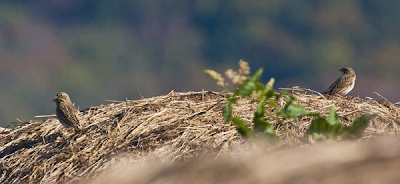
Fog was dense when I arrived and didn’t lift until 9 AM or so. The landscape was blurred, muted, and stunningly beautiful.
 Making my way along the Sherman’s Mill loop trail beginning behind the barn, I was on a search for sparrows. I was delighted to find the bridge crossing Gap Run rebuilt after a wash out out some while back. At last, the trail can accurately be called a loop again. An invisible coating of frost on the bridge ramps made using them impossible, so I had to resort to Plan B and climb up to the bridge by a judicious use of some of the bridge underpinnings.
Making my way along the Sherman’s Mill loop trail beginning behind the barn, I was on a search for sparrows. I was delighted to find the bridge crossing Gap Run rebuilt after a wash out out some while back. At last, the trail can accurately be called a loop again. An invisible coating of frost on the bridge ramps made using them impossible, so I had to resort to Plan B and climb up to the bridge by a judicious use of some of the bridge underpinnings. The stream was gorgeous as shafts of sun broke through the fog.
The stream was gorgeous as shafts of sun broke through the fog.
Sparrows were plentiful, although the diversity was less than I had hoped for. Watching Savannah, Field, and Song Spparrows playing “king of the haystack” was amusing and gave me some opportunities to photograph them as I snuck around the haystacks unseen by my subjects.

Probably the most abundant sparrow that morning was the White-throated, particularly in the dense undergrowth near the stream. Its whistled song provided the background music for much of my walk. This tan-striped morph could be a male or a female. If it was the one singing, it would have to have been a male however, since only white-striped females sing. These sparrows form stable dominance hierarchies in winter flocks.

Eastern Towhees are delightful, colorful birds also favoring dense, scrubby growth. This one was willing to perch for a few moments and expose itself, revealing its eye color. This light or reddish brown color probably indicates that it is a first fall bird. The color should change to red in winter.

Crushing a seed with its bill, this Song Sparrow kept an eye on me. Certainly the most numerous of the sparrows that day, it’s a year-round singer, particularly in mild weather.

This pretty Swamp Sparrow wears the colors of fall year round. This species was quite easy to find by its loud, sharp chip note. Found commonly throughout the winter in Northern Virginia, they persist until fairly late in the spring when we are briefly treated to their reedy trill, as they prepare for departure to their breeding grounds.

Savannah Sparrows, particularly, seemed to love the haystacks, hopping around, challenging each other for desirable spots, or so it seemed. I love the way this species sometimes seems to assume a slightly erect posture, looking eager and curious. Savannahs are seen most often in small flocks in open habitats like this farm meadow.

I watched a Red-shouldered Hawk as it called from a solitary tree far out in the meadow. I regretted not bringing my digiscoping gear because I knew this bird was far out of the reach of my 400 mm lens. No sooner had that thought passed when it was flying directly toward me. With no time to check my camera settings, I just shot away and came up with this not-too-sharp photo.

Now leafless persimmon trees were hanging heavy with fruit. Judging from the seeds in fox scat at this time of the year, these mammals and probably others, relish these seasonal treats. The fruit looked lush and ripe and I knew/thought they were edible, so I stole a low-hanging one and took it home to eat. Although wonderfully fragrant as it entered my mouth, the fruit soon produced an unpleasant, scratchy sensation and no sweetness. It was a major, but thankfully not fatal, disappointment. I need to research when, how, and if to eat this native fruit.

When I returned to the parking area near the manager’s residence and barn at the end of the morning, only one person was preparing to ride their horse along the bridle trail. I had the 462 acres almost to myself that lovely morning. No Northern Virginia birder or hiker or horseback rider should miss this heavenly place in the fall. Thank you, Mr. Mellon!




No comments:
Post a Comment